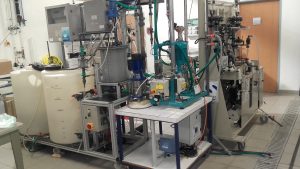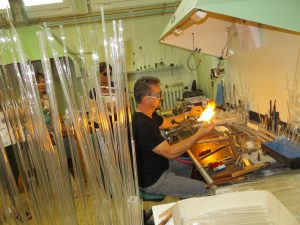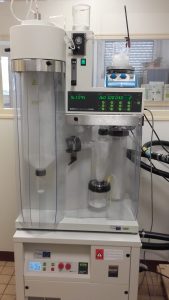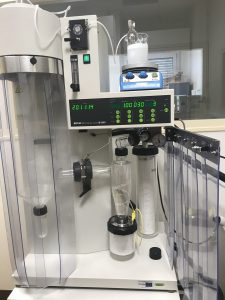What are you looking for ?
Content on this site
A person on the directory
Catalog training
Content on this site
A person on the directory
Catalog training
Manager and contact: Bertrand Gombert
The Plateforme Eaux (Waters Platform) is one of the IC2MP’s cross-disciplinary platforms at the service of its researchers. In particular, many of the research projects carried out by the E-BiCOM team (Waters, Biomarkers, Organic Contaminants, Media) are developed here.
Why set up the Plateforme Eaux?
The Plateforme Eaux provides a focal point for pilot-scale developments in the field of water treatment. In particular, the Plateforme Eaux brings together treatment pilots enabling preliminary testing for industrial applications. With a view to technology transfer to SMEs, these pilots enable expertise to be developed in collaboration with industrial research.
Fields of application
At the Plateforme Eaux, innovative water treatment and industrial effluent depollution processes can be optimized under ideal conditions, on mobile pilot units that can be coupled with more traditional water treatment technologies (such as liquid-solid separation techniques or bioreactors…).
Our services
Description
The Plateforme Eaux is organized around a technical hall (300 m2) for the installation of pilot water treatment units. It can accommodate pilot units linked to industrial projects. A laboratory, equipped with analysis facilities specific to water treatment, enables the monitoring of the treatments implemented and the performance of routine analyses.
Equipment available






The aim is to work in partnership with research teams and colleagues from other disciplines in the Cluster to provide engineering solutions in instrumentation and data processing.
This may involve the design and manufacture of fully automated custom fixtures, or the modification or adaptation of existing fixtures.
For the most part, these fixtures receive user-friendly interfacing using Labview (control, measurement and, if required, data processing).
Contact: Bertrand Leroux
Contacts: Michel Chauveau and Claude Veit
The glass blowing service enables us to manufacture and repair specific glass or quartz parts on demand. These include catalytic reactors, plasma reactors, infrared cells and electrochemical cells.
Particularly complex parts can be produced in CAD so that they can be viewed prior to manufacture.
This department is equipped with the main equipment needed for glass processing (blowing, machining). Glass lathe, disc and diamond wire saws, grinding machine, lapidary, pumping station, annealing furnaces, CAD software.
Contact: Claude Rouvier

PREMIMAT transverse platform: Preparation and shaping of Materials
This platform comprises :


The Materials Synthesis Laboratory
Role
PREMIMAT’s synthesis laboratory is used to design and develop different materials (catalysts, clays, etc.) according to precise specifications.
In addition, this laboratory enables scale-up, i.e. extrapolating the synthesis of materials to a larger scale (1kg or more).
The physical characterization of synthesized materials is carried out on PLATINA platform equipment, enabling the synthesis technique to be verified and validated.
These materials will subsequently be used in the IC2MP’s various research areas (e.g. catalytic testing).
Equipment
The laboratory is fully equipped for synthesis and processing.
Synthesis
Heat treatment
Shaping
Contact: Sophie Morisset
The lithopreparation unit
Most of the laboratory’s activity is devoted to the production of rock slides for microscopic observation, from consolidated or unconsolidated materials:
The unitt is equipped with large-capacity saws, vacuum and pressure impregnation systems, a bonding press, a lathing machine, a levelling saw and polishing machines.
Contact: Claude Laforest
– The Poitiers Hydrogeological Experimental Site (SEH) is located 2 km east of the University of Poitiers Science Campus. It covers a surface area of 12 hectares on land belonging to the University: the Jardin Botanique Universitaire (site du Deffend) in Mignaloux-Beauvoir.
– The SEH, or Site Expérimental Hydrogéologique, is dedicated to the understanding, management, forecasting and development of water resources in highly heterogeneous environments.
Awarded the ORE-H+ environmental research observatory label by the French Ministry of Research, it comprises some forty boreholes over 130 metres deep, spread over a surface area of around ten hectares. It is managed within the IC2MP by the HydrASA team (Hydrogeology, Clays, Soils and Alterations).
– The SEH is part of the Réseau National de Sites Hydrogéologiques (H+ network), part of the OZCAR (Observatoire de la Zone Critique, Applications, Recherche) research infrastructure, which brings together all instrumented sites dedicated to studying the functioning of land surfaces.
To this end, the HydrASA team maintains a network of automatic data-acquisition stations to continuously monitor meteorological parameters and piezometric levels in each borehole. After validation, the recorded data are systematically entered into the H+ database, the structure of which was developed jointly by HydrASA and the Géosciences Rennes team (UMS 3343 OSUR).
Such long-term monitoring is essential for studying and modeling the natural dynamics of water and chemical species flows in solution, as the physico-geochemical processes involved can have relatively long characteristic times.
The SEH’s long-term viability is ensured by funding from INSU and by specific training activities on site.
This IC2MP platform lies at the interface between biology and chemistry. Its mission is to study the behavior of living organisms (bacteria, murine or human cells or animals) in response to molecules or materials developed by chemists. This activity has developed mainly within the ORGASYNTH team, but also with the MEDIACAT team and through inter-team work with ORGASYNTH / E-BICOM. The biology expertise of the members of this platform provides a highly complementary perspective to the IC2MP’s activities in the fields of health and the environment.
Equipment
To carry out these experiments, the platform has all the basic biology equipment (electrophoresis apparatus, real-time thermocycler, microbiological safety station, CO2 incubator, cell counter, etc.) and uses the University of Poitiers’ shared platforms (confocal and electron microscopy, flow cytometry and animal experimentation platform). After discussions with chemists, the platform offers biological techniques designed to decipher the interactions between chemical compounds and living organisms.